1997 BUICK REGAL torque
[x] Cancel search: torquePage 10 of 422
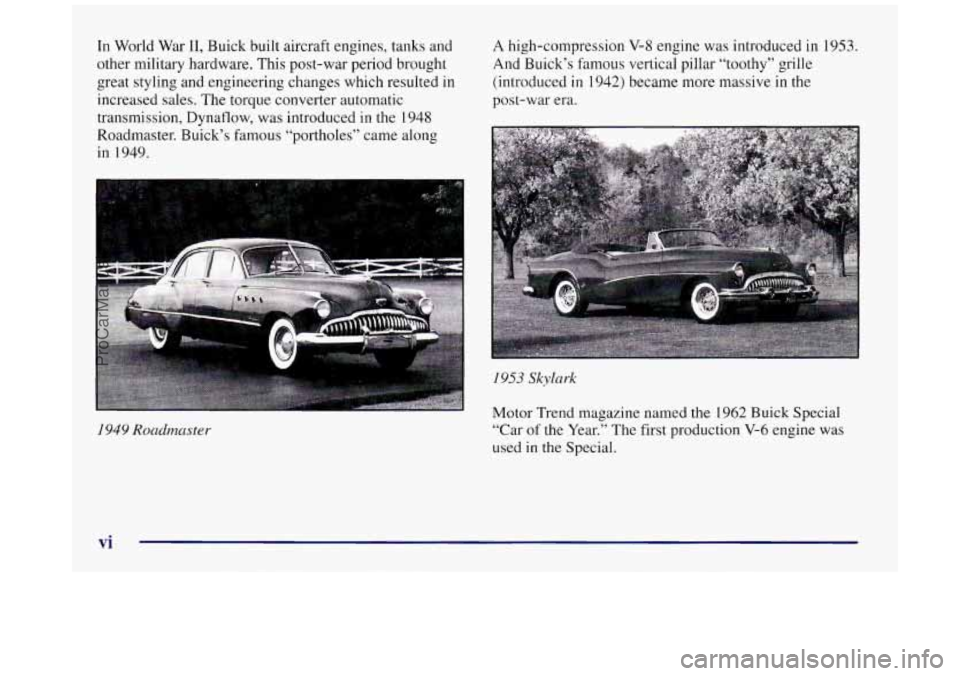
In World War 11, Buick built aircraft engines, tanks and
other military hardware. This post-war period brought
great styling and engineering changes which resulted in
increased sales. The torque converter automatic
transmission, Dynaflow, was introduced in the 1948 Roadmaster. Buick’s famous “portholes” came along
in 1949.
1949 Roadmaster
A high-compression V-8 engine was introduced in 1953.
And Buick’s famous vertical pillar
“toothy” grille
(introduced
in 1942) became more massive in the
post-war era.
I953 Skylark
Motor Trend magazine named the 1962 Buick Special
“Car
of the Year.” The first production V-6 engine was
used in the Special.
vi
ProCarManuals.com
Page 106 of 422
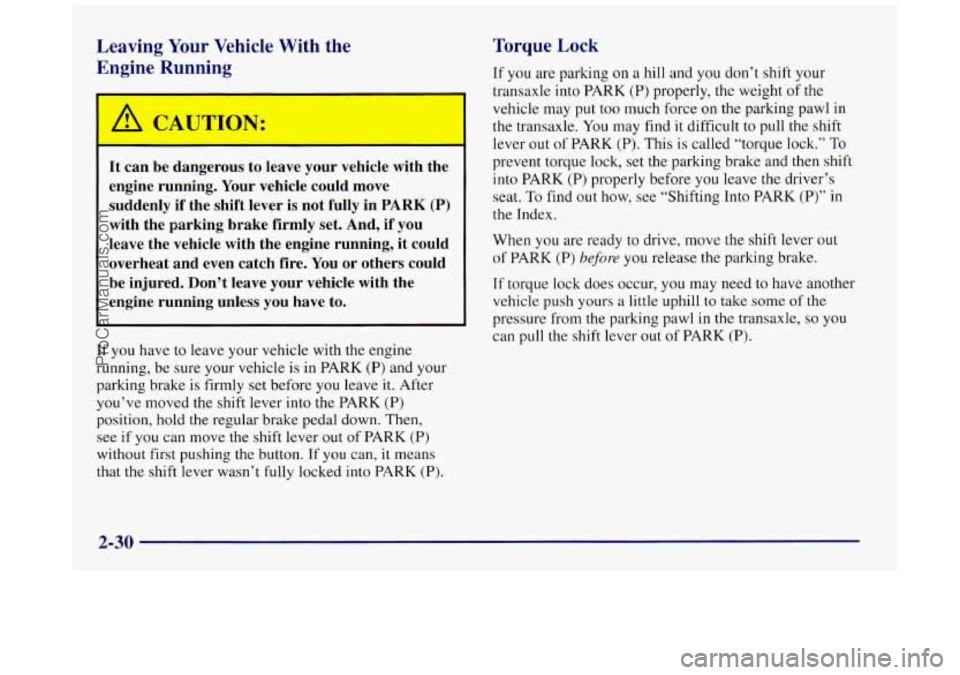
Leaving Your Vehicle With the
Engine Running
It can be dangerous to leave your vehicle with the
engine running. Your vehicle could move
suddenly if the shift lever
is not fully in PARK (P)
with the parking brake firmly set. And, if you
leave the vehicle with the engine running,
it could
overheat and even catch fire. You or others could
be injured. Don’t leave your vehicle with the
engine running unless you have to.
If you have to leave your vehicle with the engine
running, be sure your vehicle is in PARK (P) and your
parking brake is firmly
set before you leave it. After
you’ve moved the shift lever into the PARK (P)
position, hold the regular brake pedal down. Then,
see
if you can move the shift lever out of PARK (P)
without first pushing the button. If
you can, it means
that the shift lever wasn’t fully locked into PARK
(P).
Torque Lock
If you are parking on a hill and you don’t shift your
transaxle into PARK (P) properly, the weight of the
vehicle may put too much force on the parking pawl in
the transaxle.
You may find it difficult to pull the shift
lever out
of PARK (P). This is called “torque lock.” To
prevent torque lock, set the parking brake and then shift
into PARK
(P) properly before you leave the driver’s
seat.
To find out how, see “Shifting Into PARK (P)” in
the Index.
When you are ready to drive, move the shift lever out
of PARK (P) before you release the parking brake.
If torque lock does occur, you may need to have another
vehicle push yours
a little uphill to take some of the
pressure from the parking pawl in the transaxle, so you
can pull the shift lever out of PARK (P).
2-30
ProCarManuals.com
Page 270 of 422
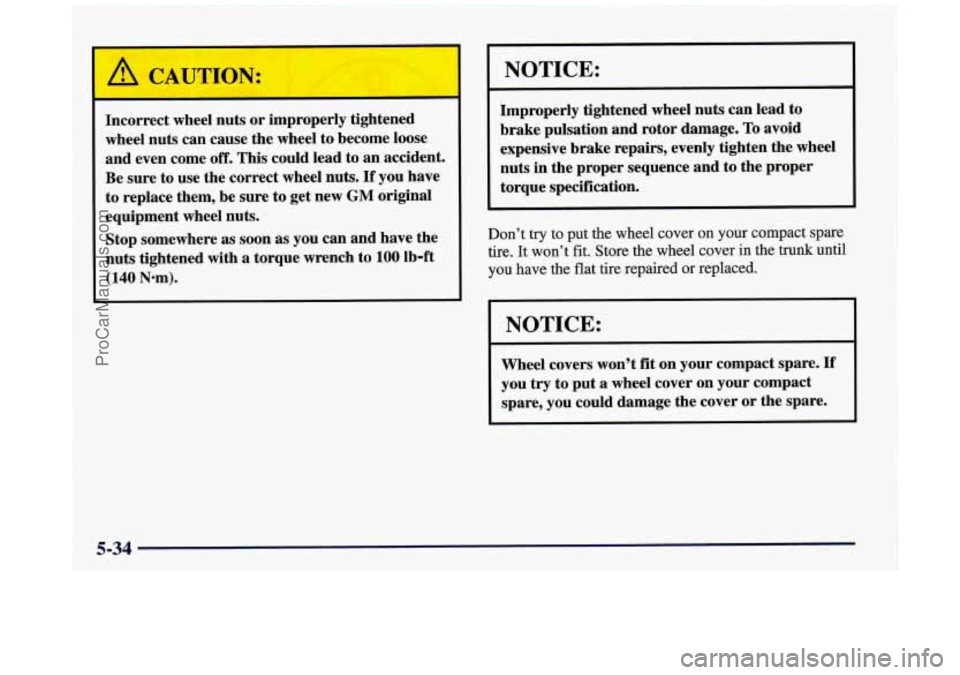
-
Incorrect wheel nuts or improperly tightened
wheel nuts can cause the wheel to become loose
and even come
off. This could lead to an accident.
Be sure to use the correct wheel nuts.
If you have
to replace them, be sure to get new GM original
equipment wheel nuts.
Stop somewhere
as soon as you can and have the
nuts tightened with
a torque wrench to 100 lb-ft
(140 Nom).
5-34
I NOTICE:
Improperly tightened wheel nuts can lead to
brake pulsation and rotor damage. To avoid
expensive brake repairs, evenly tighten the wheel
nuts in the proper sequence and to the proper
torque specification.
Don’t try to put the wheel cover on your compact spare
tire. It won’t fit. Store the wheel cover
in the trunk until
you have the flat tire repaired or replaced.
NOTICE:
Wheel covers won’t fit on your compact spare. If
you try to put a wheel cover on your compact
spare, you could damage the cover or the spare.
ProCarManuals.com
Page 294 of 422
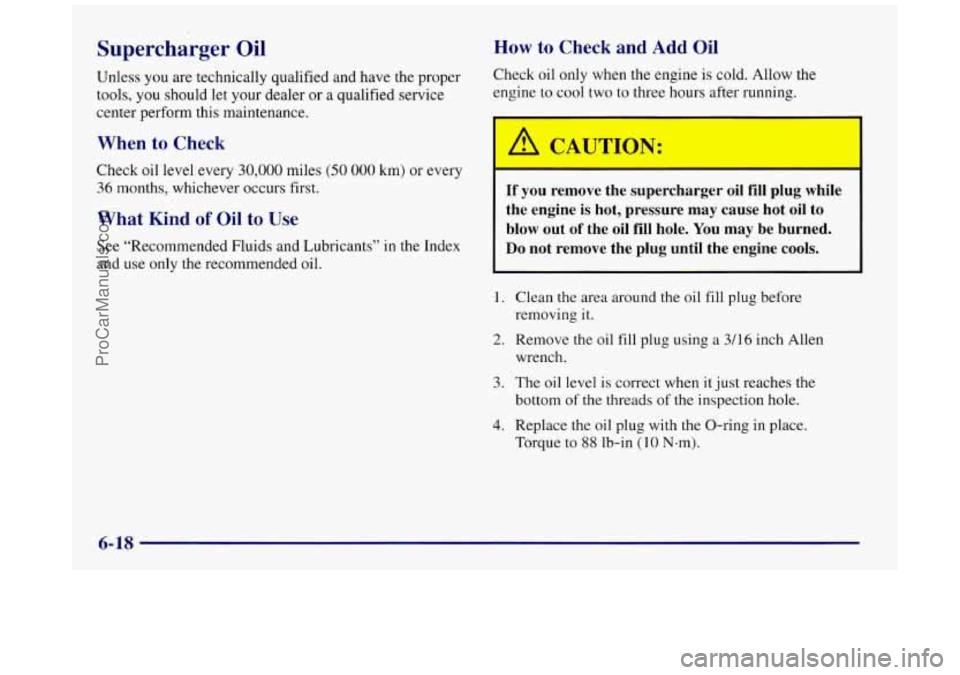
Supercharger Oil
Unless you are technically qualified and have the proper
tools, you should let your dealer or a qualified service
center perform this maintenance.
When to Check
Check oil level every 30,000 miles (50 000 km) or every
36 months, whichever occurs first.
What Kind of Oil to Use
See “Recommended Fluids and Lubricants’’ in the Index
and use only the recommended oil.
How to Check and Add Oil
Check oil only when the engine is cold. Allow the
engine to cool two to three hours after running.
If you remove the supercharger oil fill plug while
the engine is hot, pressure may cause
hot oil to
blow out
of the oil fill hole. You may be burned.
Do not remove the plug until the engine cools.
1.
2.
3.
3.
Clean the area around the oil fill plug before
removing it.
Remove
the oil fill plug using a 3/16 inch Allen
wrench.
The oil level is correct when
it just reaches the
bottom
of the threads of the inspection hole.
Replace the oil plug with the O-ring
in place.
Torque to
88 lb-in (10 N-m).
6-18
ProCarManuals.com
Page 307 of 422
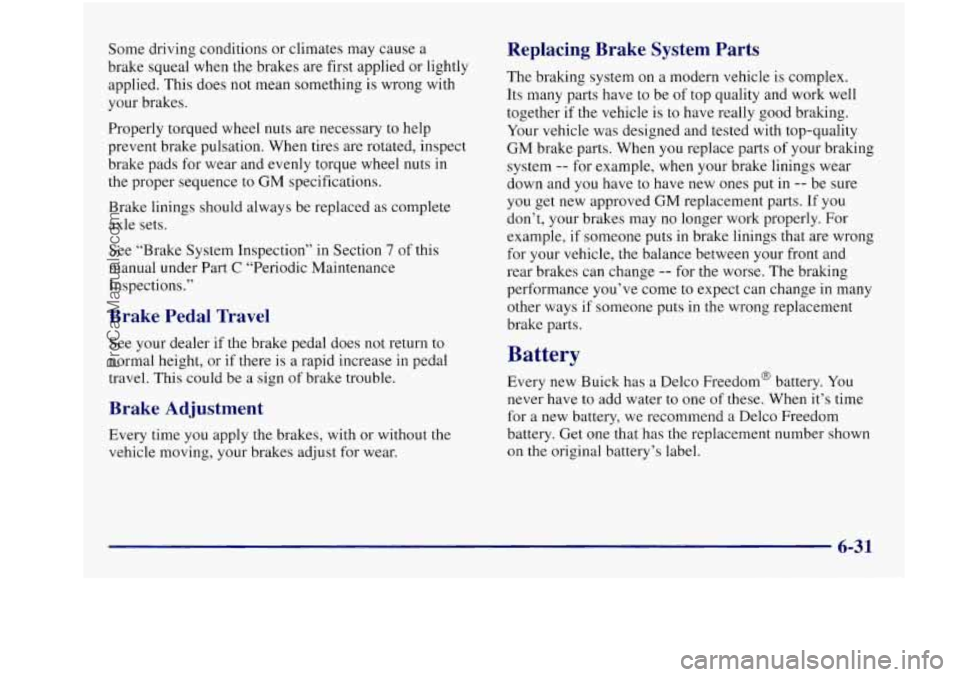
Some driving conditions or climates may cause a
brake squeal when the brakes are first applied or lightly
applied. This does
not mean something is wrong with
your brakes.
Properly torqued wheel nuts are necessary to help
prevent brake pulsation. When tires are rotated, inspect
brake pads for wear and evenly torque wheel nuts
in
the proper sequence to GM specifications.
Brake linings should always be replaced as complete
axle sets.
See “Brake System Inspection” in Section
7 of this
manual under Part
C “Periodic Maintenance
Inspections.”
Brake Pedal Travel
See your dealer if the brake pedal does not return to
normal height, or if there is a rapid increase
in pedal
travel. This could be a sign of brake trouble.
Brake Adjustment
Every time you apply the brakes, with or without the
vehicle moving, your brakes adjust for wear.
Replacing Brake System Parts
The braking system on a modern vehicle is complex.
Its many parts have to be of top quality and work well
together if the vehicle is to have really good braking.
Your vehicle was designed and tested with top-quality
GM brake parts. When you replace parts
of your braking
system
-- for example, when your brake linings wear
down and you have to have new ones put in
-- be sure
you get new approved GM replacement parts. If you
don’t, your brakes may no longer work properly. For
example,
if someone puts in brake linings that are wrong
for your vehicle, the balance between your front and
rear brakes can change
-- for the worse. The braking
performance you’ve come
to expect can change in many
other ways if someone puts in the wrong replacement
brake parts.
Battery
Every new Buick has a Delco Freedom@ battery. You
never have to add water to one of these. When it’s time
for a new battery, we recommend a Delco Freedom
battery. Get one that has the replacement number shown
on the original battery’s label.
~ 6-31
ProCarManuals.com
Page 317 of 422

How to Check
Use a good quality pocket-type gage to check tire
pressure. You can’t tell if your tires are properly inflated
simply by looking at them. Radial tires may
look
properly inflated even when they’re underinflated.
Be sure
to put the valve caps back on the valve stems.
They help prevent leaks by keeping out dirt and moisture.
Tire Inspection and Rotation
Tires should be rotated every 6,000 to 8,000 miles
(10 000 to 13 000 km). Any time you notice unusual
wear, rotate your tires as soon as possible and check
wheel alignment. Also check for damaged tires or
wheels. See “When It’s Time for New Tires” and
“Wheel Replacement” later in this section for
more information.
The purpose of regular rotation is to achieve more
uniform wear for
all tires on the vehicle. The first
rotation is the most important. See “Scheduled
Maintenance Services” in the Index for scheduled
rotation intervals. When
rotating your tires, always use the correct rotation
pattern shown here.
Don’t include the compact spare tire in your tire rotation.
After the tires have been rotated, adjust
the front and
rear inflation pressures as shown on the Tire-Loading
Information label. Make certain that all wheel nuts are
properly tightened. See “Wheel Nut Torque” in the Index.
ProCarManuals.com
Page 339 of 422
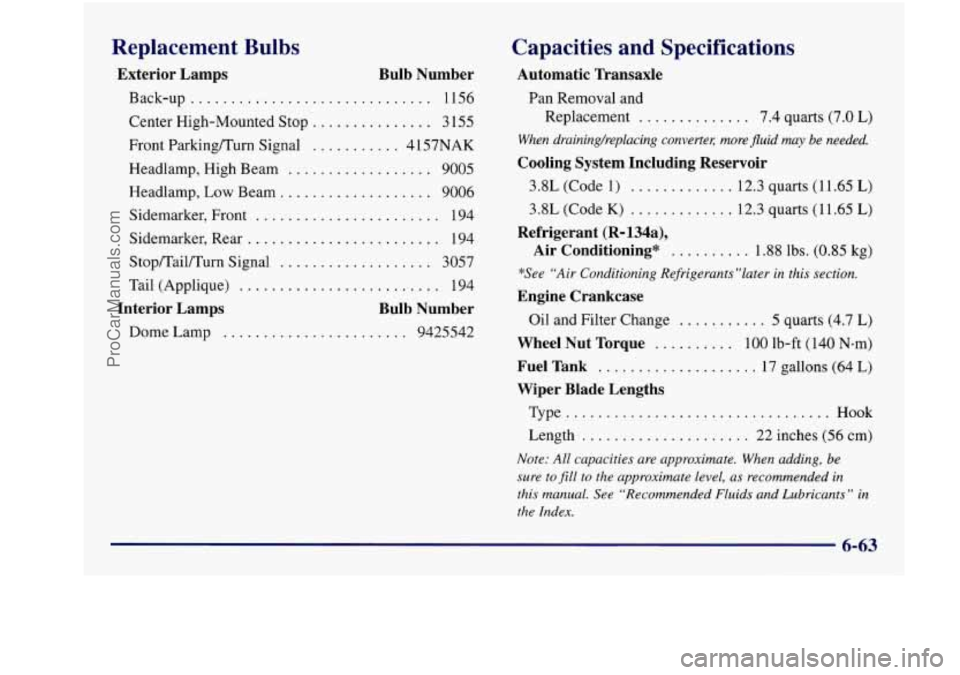
Replacement Bulbs
Exterior Lamps Bulb Number
Back-up .............................. 1156
Center High-Mounted Stop
............... 3 155
Front Parking/Turn Signal
........... 4 157NAK
Headlamp, High Beam
.................. 9005
Headlamp,
Low Beam. .................. 9006
Sidemarker, Front
....................... 194
Sidemarker, Rear
........................ 194
Stop/Tail/Turn Signal
................... 3057
Tail (Applique)
......................... 194
Interior Lamps Bulb Number
Dome Lamp ....................... 9425542
Capacities and Specifications
Automatic nansaxle
Pan Removal and
Replacement
.............. 7.4 quarts (7.0 L)
When drainingheplacing converter; more fluid my be needed.
Cooling System Including Reservoir
3.8L (Code 1) ............. 12.3 quarts (1 1.65 L)
3.8L (Code K) ............. 12.3 quarts (1 1.65 L)
Air Conditioning* .......... 1.88 lbs. (0.85 kg)
Refrigerant (R=134a),
*See “Air Conditioning Refrigerants”1ater in this section.
Engine Crankcase
Oil and Filter Change ........... 5 quarts (4.7 L)
Wheel Nut Torque .......... 100 lb-ft (140 N-m)
Fuel Tank .................... 17 gallons (64 L)
Wiper Blade Lengths
Type ................................. Hook
Length ..................... 22 inches (56 cm)
Note: All capacities are approximate. When adding, be
sure to
fill to the approximate level, as recommended in
this manual. See “Recommended Fluids and Lubricants
” in
the Index.
6-63
ProCarManuals.com
Page 417 of 422
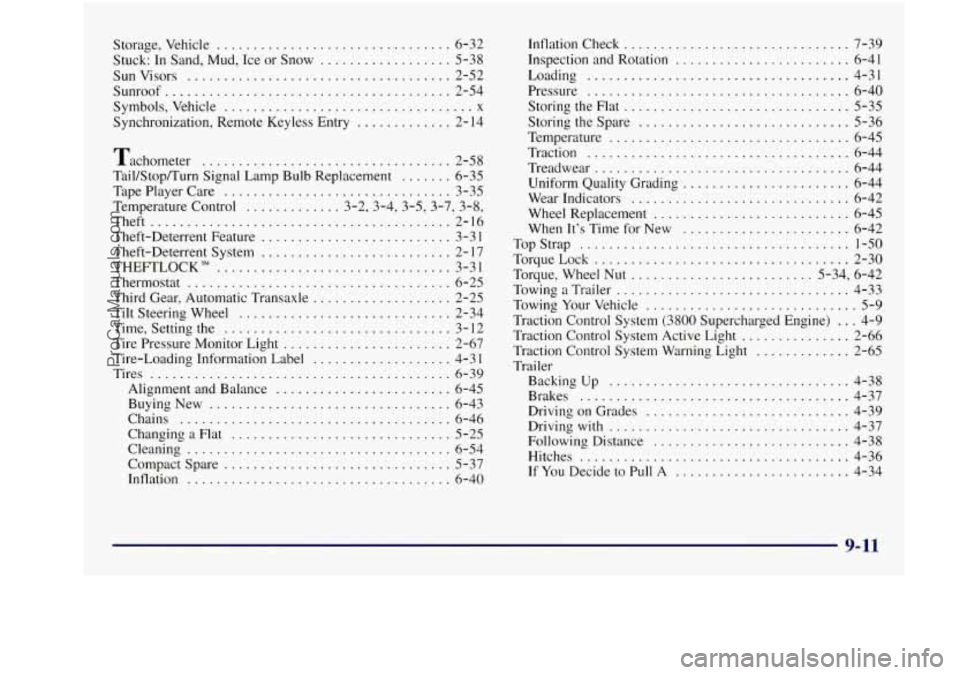
Storage. Vehicle ................................ 6-32
Stuck: In Sand. Mud. Ice or Snow
.................. 5-38
Sun Visors
.................................... 2-52
Sunroof
....................................... 2-54
Symbols. Vehicle
.................................. x
Synchronization. Remote Keyless Entry ............. 2- 14
Tachometer .................................. 2-58
Tail/Stop/Turn Signal Lamp Bulb Replacement
....... 6-35
TapePlayerCare
............................... 3-35
Temperature Control
............. 3-2. 3.4. 3.5. 3.7. 3.8.
Theft
......................................... 2-16
Theft-Deterrent Feature
.......................... 3-3 1
Theft-Deterrent System .......................... 2- 17
Thermostat
.................................... 6-25
Third Gear, Automatic Transaxle
................... 2-25
Tilt Steering Wheel
............................. 2-34
Time. Setting the
............................... 3- 12
Tire Pressure Monitor Light
....................... 2-67
Tire-Loading Information Label
................... 4-3 1
Tires ......................................... 6-39
Alignment and Balance
........................ 6-45
BuyingNew
................................. 6-43
Chains
..................................... 6-46
Changing
a Flat .............................. 5-25
Cleaning .................................... 6-54
Compact Spare
............................... 5-37
Inflation
.................................... 6-40
THEFTLOCK" ................................. 3-31 Inflation Check
............................... 7-39
Inspection and Rotation
........................ 6-41
Loading
.................................... 4-31
Pressure
.................................... 6-40
Storing the Flat
............................... 5-35
Storing the Spare
............................. 5-36
Temperature
................................. 6-45
Traction
.................................... 6-44
Treadwear
................................... 6-44
Uniform Quality Grading
....................... 6-44
Wear Indicators
.............................. 6-42
Wheel Replacement
........................... 6-45
When It's Time for New
....................... 6-42
TopStrap
..................................... 1-50
TorqueLock
................................... 2-30
Torque. Wheel
Nut ......................... 5.34. 6.42
Towing
a Trailer ................................ 4-33
Towing Your Vehicle
............................. 5-9
Traction Control System (3800 Supercharged Engine)
... 4-9
Traction Control System Active Light
............... 2-66
Traction Control System Warning Light
............. 2-65
Trailer Backing
Up ................................. 4-38
Brakes
..................................... 4-37
Driving on Grades
............................ 4-39
Driving
with ................................. 4-37
Following Distance
........................... 4-38
Hitches
..................................... 4-36
If You Decide to Pull A ........................ 4-34
9-11
ProCarManuals.com